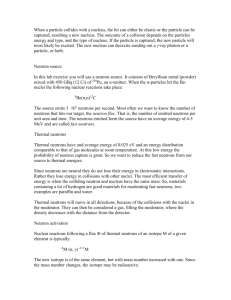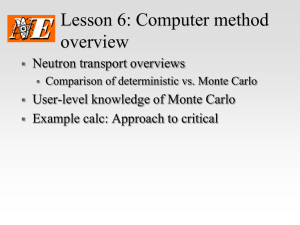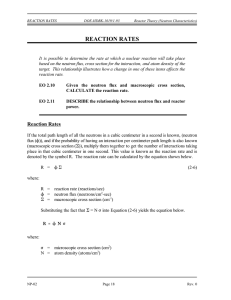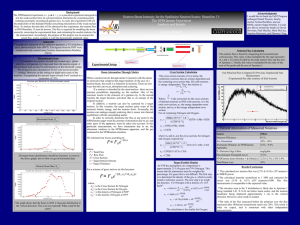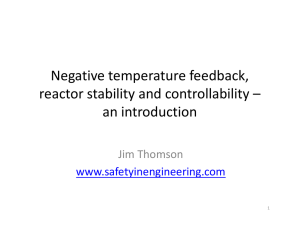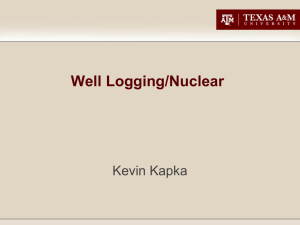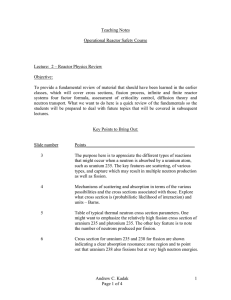Neutron transport
advertisement
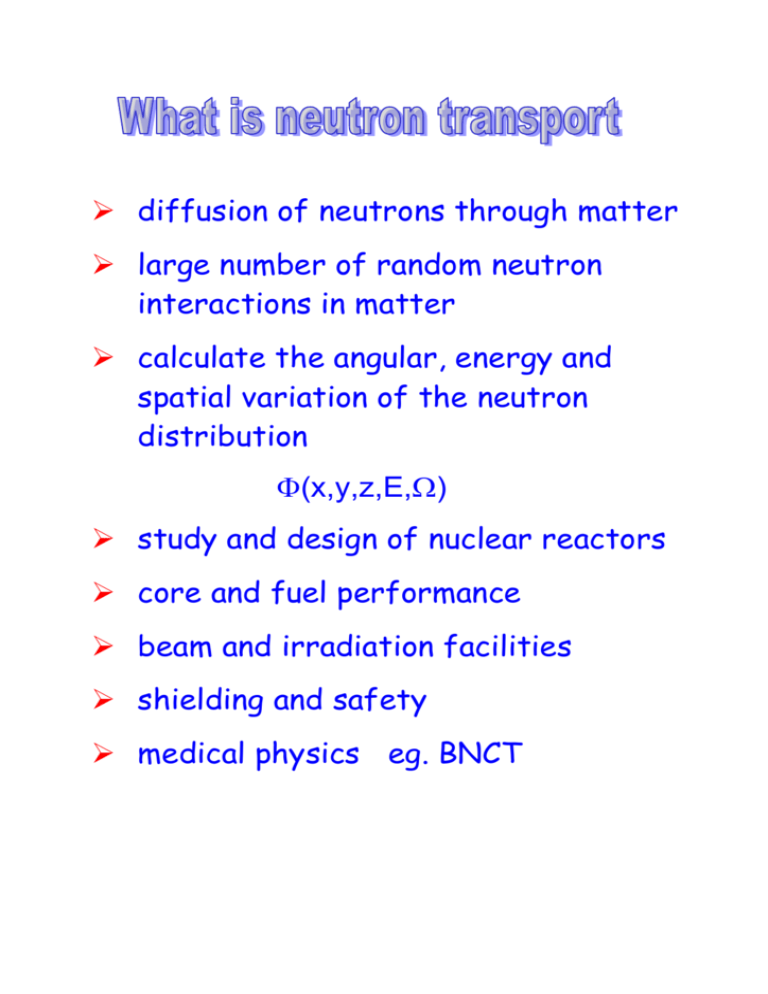
diffusion of neutrons through matter large number of random neutron interactions in matter calculate the angular, energy and spatial variation of the neutron distribution (x,y,z,E,) study and design of nuclear reactors core and fuel performance beam and irradiation facilities shielding and safety medical physics eg. BNCT scattering v1 , E1 , 1 vo, Eo, o elastic v1 , E1 , 1 vo, Eo, o inelastic vo, Eo, o absorption eg. (n,) vi, Ei, i vo, Eo, o fission n Flux is the number of neutrons crossing the surface (perpendicular to the direction of motion) per area per time d Flux is the total number of neutrons passing through a surface, that is perpendicular to each neutron direction, per area per time. Direction doesn’t matter. What is neutron transport The neutron transport equation Solving the neutron transport equation Deterministic methods PL approximation Diffusion equation Discrete ordinates Monte Carlo Typical reactor calculation Work on RRR dz dy x x + dx neutrons going out – neutrons going in x ((x+dx) - (x)) dy dz + y ((y+dy) - (y)) dx dz + z ((z+dz) - (z)) dy dx dV no sources or collisions) sources - losses (collisions) Q + (E’E,’) d’dE’ - (E) (E’) f(E’) d’dE’ k 4 + (E’E,’) d’dE’ - analytic solution only for simple geometries and even then with approximations, such as isotropic scattering provide insight to real reactors that are similar to calculated geometries allow comparison of results from other approximate techniques expand the angular flux in terms of the spherical harmonics 2l 1 l ( x, y, z, E , ) lm ( x, y, z, E )Ylm () l 0 4 m l 2l 1 s sl Pl (cos ) l 0 4 we can integrate equations over all angles and eliminate from equations for 1D cases can calculate to high order for 2D and 3D usually take only the first 2 terms ie. l = 1. This is the P1 approximation. starting from the P1 equations and assuming a << we obtain -D (E) (E’) f(E’)dE’ k + (E’E) dE’ - J = -D Fick’s law 1 D 3( 0 s ) good approximation for slowly varying flux poor near boundaries of materials within a few mfp. solve the transport equation for a set of discrete directions m these directions are weighted according to the solid angle subtended wm = m/4 ( x, y, z, E ) wm m ( x, y, z, E ) m not limited by large flux gradients can bias the direction angles towards a direction of high importance formulation allows efficient coding for numerical solution using computers 2 1 number of neutrons crossing each surface (per time) is A for 1 A cos for simplify the energy representation by using group cross-sections a group is an energy interval Ei E Ei+1 average the point cross-sections using some estimated neutron spectrum usually this is a fission emission spectrum + a 1/E spectrum + a Maxwellian thermal spectrum Ei 1 Ei ( E )( E )dE g Ei 1 Ei ( E )dE need to divide the space co-ordinates into a set of discrete values this is the mesh material 1 material 2 material 3 we assume average values for and within any mesh interval we approximate derivatives with differences d ( x x) ( x) dx x impose continuity of flux and current across common boundaries between mesh intervals obtain a set of linear equations relating (x) and the (xi) in surrounding mesh intervals solve using various methods inner iterations – the fission and scattering sources are kept constant and the group fluxes are solved outer iterations – the fission and scattering sources are recalculated start calculation with a flat flux and then calculate fission source cross-section library must be condensed. Anything from 100’s groups to 20-50 groups. too much detail in the core fuel meat, cladding and coolant channel cell calculation, represent the fuel meat, cladding and coolant channel cladding fuel coolant perform in 1D using reflective boundary conditions ie. infinite lattice Use discrete ordinates homogenise and condense crosssections using the flux solution i iVi I iI iVi iI perform a supercell calculation, whole fuel element homogenise the supercell material and perform a whole reactor calculation. Diffusion or discrete ordinates. do not solve any transport equations simulate the neutron tracks through the system of interest (reactor) there are no averages over energy, space or time. All aspects of the problem are simulated events happen at random sample next interaction position Probability that a neutron travels a distance x without interaction is P = e-x If P is a uniformly sampled random number then the distance is given by x = ln P / sample interaction from all possible interactions according to their relative cross-sections depending on interaction sample the corresponding neutron energy and angular distribution etc. sample many events to accumulate sufficient statistics to calculate the required results Monte Carlo can be slow especially reactor calculations. Most of the time is spent calculating the source. usually no simple way to calculate the flux distribution variance reduction techniques exist shield core reflector



